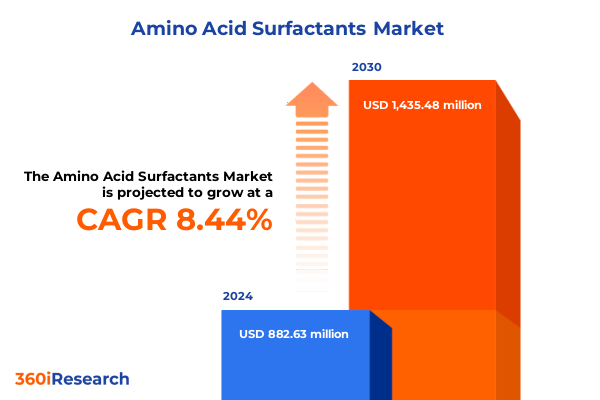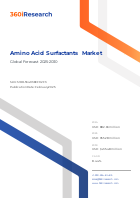The Amino Acid Surfactants Market size was estimated at USD 882.63 million in 2024 and expected to reach USD 955.28 million in 2025, at a CAGR 8.44% to reach USD 1,435.48 million by 2030.

Unveiling the Amino Acid Surfactants Landscape
Amino acid surfactants have emerged as a cornerstone of sustainable formulation strategies, bringing together high-performance surface activity and exceptional biodegradability. As industries from personal care to agriculture navigate evolving regulatory frameworks and heightened consumer expectations, these gentle yet effective molecules are reshaping the very definition of green chemistry.
This executive summary introduces the critical factors driving adoption, from the molecular innovation behind alkylated amino acids to the broader implications for supply chains and end‐use performance. By examining current market dynamics, technological breakthroughs and regulatory catalysts, this introduction sets the stage for a comprehensive exploration of how amino acid surfactants are redefining standards in efficacy, safety and environmental responsibility.
Transformative Shifts Reshaping the Surfactants Arena
The surfactants industry is undergoing transformative shifts as brand owners and formulators pivot toward bio-based, renewable ingredients. Heightened scrutiny on raw material sourcing has accelerated the move away from petrochemical-derived surfactants toward amino acid–based alternatives. This transition has been amplified by tightening environmental regulations and stringent biodegradability requirements across major markets.
Simultaneously, advances in enzymatic synthesis and green manufacturing processes have slashed production costs while enhancing purity profiles. These developments have not only broadened the appeal of alkyl-amino acids and dipeptide surfactants but also catalyzed strategic partnerships between ingredient innovators and consumer goods giants. As functional benefits such as mildness and foaming performance continue to meet or exceed legacy surfactants, the industry is witnessing a paradigm shift that merges sustainability imperatives with uncompromised efficacy.
Assessing the Ripple Effects of US Tariffs in 2025
The imposition of new United States tariffs in 2025 on key amino acid derivatives has created a complex web of cost and supply chain considerations. Import duties on critical raw materials, particularly those originating from Asia-Pacific suppliers, have incrementally driven up procurement expenses for manufacturers. This escalation has prompted many to reassess sourcing strategies and explore domestic production capabilities to mitigate exposure to tariff volatility.
Moreover, the cumulative impact extends beyond pricing pressures. Some downstream processors have accelerated long-term contracts with non-U.S. suppliers to secure competitive rates, while others have invested in backward integration to stabilize supply. In parallel, regulatory uncertainties have reinforced the necessity for flexible procurement frameworks. Accordingly, companies that proactively diversified their supplier base and optimized logistical networks have managed to preserve margins and maintain product availability despite the tariff headwinds.
Decoding Segmentation Insights for Strategic Decisions
A granular view of market segmentation underscores distinct growth trajectories across type, form and application dimensions. On the type front, formulations built around Alkyl-L-amino acids and Alkyl-L-glutamate are gaining traction for their superior mildness and emulsification properties, even as dipeptide surfactants carve out niche roles in premium personal care blends. Granular, liquid and powder presentations each cater to unique processing requirements, offering formulators a spectrum of flexibility in manufacturing and dosing.
When evaluating end-use applications, agriculture and cosmetics command steady demand as formulators leverage amino acid surfactants to enhance pesticide dispersion and product gentleness. Household cleaning products, spanning dishwashing liquids, laundry detergents and surface cleaners, continue to adopt these molecules for their grease-cutting power and rapid biodegradability. Meanwhile, the personal care and cosmetics arena-encompassing body washes and shampoos, facial cleansers, skin care products and toothpastes-remains a high-growth segment, driven by consumer appetite for gentle, skin-compatible cleansing agents.
This comprehensive research report categorizes the Amino Acid Surfactants market into clearly defined segments, providing a detailed analysis of emerging trends and precise revenue forecasts to support strategic decision-making.
- Type
- Form
- Applications
Regional Dynamics Driving Global Market Momentum
Regional dynamics reveal divergent growth patterns and regulatory drivers across major markets. In the Americas, established regulatory frameworks and strong consumer demand for natural formulations have sustained consistent expansion, with formulators focusing on value-added, multifunctional blends. Europe, Middle East & Africa present a mosaic of regulatory landscapes, where stringent REACH requirements and emerging Gulf markets offer both challenges and untapped potential for innovators prioritizing compliance and sustainability.
Asia-Pacific remains the fastest-growing region, fueled by rising disposable incomes, expanding personal care industries and government initiatives supporting bio-based manufacturing. Local producers in China and India are scaling up capacity, while Southeast Asian markets are awakening to the advantages of amino acid surfactants in agriculture and cleaning applications. Together, these regional dynamics form a mosaic of opportunity, highlighting the need for tailored market entry and growth strategies.
This comprehensive research report examines key regions that drive the evolution of the Amino Acid Surfactants market, offering deep insights into regional trends, growth factors, and industry developments that are influencing market performance.
- Americas
- Europe, Middle East & Africa
- Asia-Pacific
Profiling Industry Leaders and Competitive Maneuvers
Leading players have responded to market opportunities with an array of strategic initiatives, from capacity expansions to targeted product launches emphasizing bio-based purity and performance. Several global specialty chemical firms have intensified investment in research centers to optimize enzymatic production of alkyl-amino acids, thereby enhancing cost competitiveness and sustainability credentials.
In addition, dynamic partnerships between surfactant innovators and contract manufacturers have streamlined scale-up timelines, enabling faster commercial adoption. Mergers and acquisitions continue to reshape competitive positioning, as companies seek to bolster their portfolios with peptide-based platforms and proprietary delivery systems. These moves underscore the rising strategic importance of amino acid surfactants as a core component in sustainable formulation arsenals.
This comprehensive research report delivers an in-depth overview of the principal market players in the Amino Acid Surfactants market, evaluating their market share, strategic initiatives, and competitive positioning to illuminate the factors shaping the competitive landscape.
- Aarti Surfactants Limited
- Ajinomoto Co., Inc.
- BASF SE
- Clariant AG
- Colonial Chemical, Inc.
- Croda International Plc
- Dow Chemical Company
- Galaxy Surfactants Limited
- Huntsman Corporation
- Innospec Inc. by Octel Corporation
- INOLEX Inc.
- Kao Corporation
- Merck KGaA
- Miwon Commercial Co., Ltd.
- Pilot Chemical Company
- Sabo S.p.A
- Seppic S.A.
- Sinerga S.p.A.
- Sino Lion USA
- Solvay S.A.
- Stepan Company
- Taiwan NJC Corp.
- The Lubrizol Corporation
- Tokyo Chemical Industry Co., Ltd.
- Zschimmer & Schwarz GmbH & Co KG
Actionable Strategies for Leading Surfactant Innovators
Industry leaders are poised to capitalize on expanding demand by prioritizing R&D investment in next-generation enzymatic pathways and tailored peptide surfactant architectures. Short-term actions should include strengthening supplier relationships to secure access to glutamic acid derivatives and collaborating with OEMs to co-develop application-specific formulations. Mid-term strategies involve scaling up biorefinery capacities and integrating digital process controls to optimize yields and reduce operational variability.
Longer-term imperatives call for forging alliances across the value chain, from amino acid producers to consumer brands, to co-create differentiated solutions that meet evolving sustainability and performance benchmarks. By adopting a holistic approach-encompassing raw material innovation, green manufacturing and customer-centric application development-industry leaders will be well positioned to set new standards and capture disproportionate share in emerging markets.
Rigorous Research Methodology Underpinning Insights
This analysis draws upon a robust research framework combining in-depth secondary research, expert interviews and rigorous data triangulation. Industry publications, regulatory filings and proprietary databases were systematically reviewed to assemble a comprehensive universe of global amino acid surfactant participants and end-users.
Primary insights were obtained through structured interviews with senior R&D executives, procurement leaders and regulatory specialists across key regions. Quantitative metrics were validated through cross-referencing company disclosures, trade data and patent filings. This methodology ensures that findings rest on reliable, multi-source evidence, providing stakeholders with confidence in the accuracy and relevance of strategic recommendations.
Explore AI-driven insights for the Amino Acid Surfactants market with ResearchAI on our online platform, providing deeper, data-backed market analysis.
Ask ResearchAI anything
World's First Innovative Al for Market Research
Concluding Perspectives on Market Evolution
In conclusion, amino acid surfactants stand at the confluence of performance, sustainability and regulatory alignment. The industry’s trajectory is shaped by transformative technological advancements, evolving tariff landscapes and nuanced regional dynamics. Segmentation analysis reveals diverse opportunities across type, form and application vectors, while competitive intelligence highlights the importance of strategic partnerships and targeted capacity expansions.
As market participants navigate these complex forces, the ability to integrate scientific innovation with agile supply chain strategies will determine success. By leveraging the insights presented herein, decision-makers can chart a proactive path to growth and differentiate their offerings in an increasingly eco‐conscious marketplace.
This section provides a structured overview of the report, outlining key chapters and topics covered for easy reference in our Amino Acid Surfactants market comprehensive research report.
- Preface
- Research Methodology
- Executive Summary
- Market Overview
- Market Dynamics
- Market Insights
- Cumulative Impact of United States Tariffs 2025
- Amino Acid Surfactants Market, by Type
- Amino Acid Surfactants Market, by Form
- Amino Acid Surfactants Market, by Applications
- Americas Amino Acid Surfactants Market
- Europe, Middle East & Africa Amino Acid Surfactants Market
- Asia-Pacific Amino Acid Surfactants Market
- Competitive Landscape
- ResearchAI
- ResearchStatistics
- ResearchContacts
- ResearchArticles
- Appendix
- List of Figures [Total: 22]
- List of Tables [Total: 239 ]
Engage with Ketan Rohom to Access In-Depth Analysis
To secure the full-depth analysis, comprehensive data tables, detailed case studies and proprietary insights, reach out directly to Ketan Rohom, Associate Director, Sales & Marketing. He will guide you through tailored options for accessing the complete market research report and ensure you have the strategic intelligence needed to outpace competitors and capitalize on emerging opportunities in the amino acid surfactants landscape.

- How big is the Amino Acid Surfactants Market?
- What is the Amino Acid Surfactants Market growth?
- When do I get the report?
- In what format does this report get delivered to me?
- How long has 360iResearch been around?
- What if I have a question about your reports?
- Can I share this report with my team?
- Can I use your research in my presentation?




